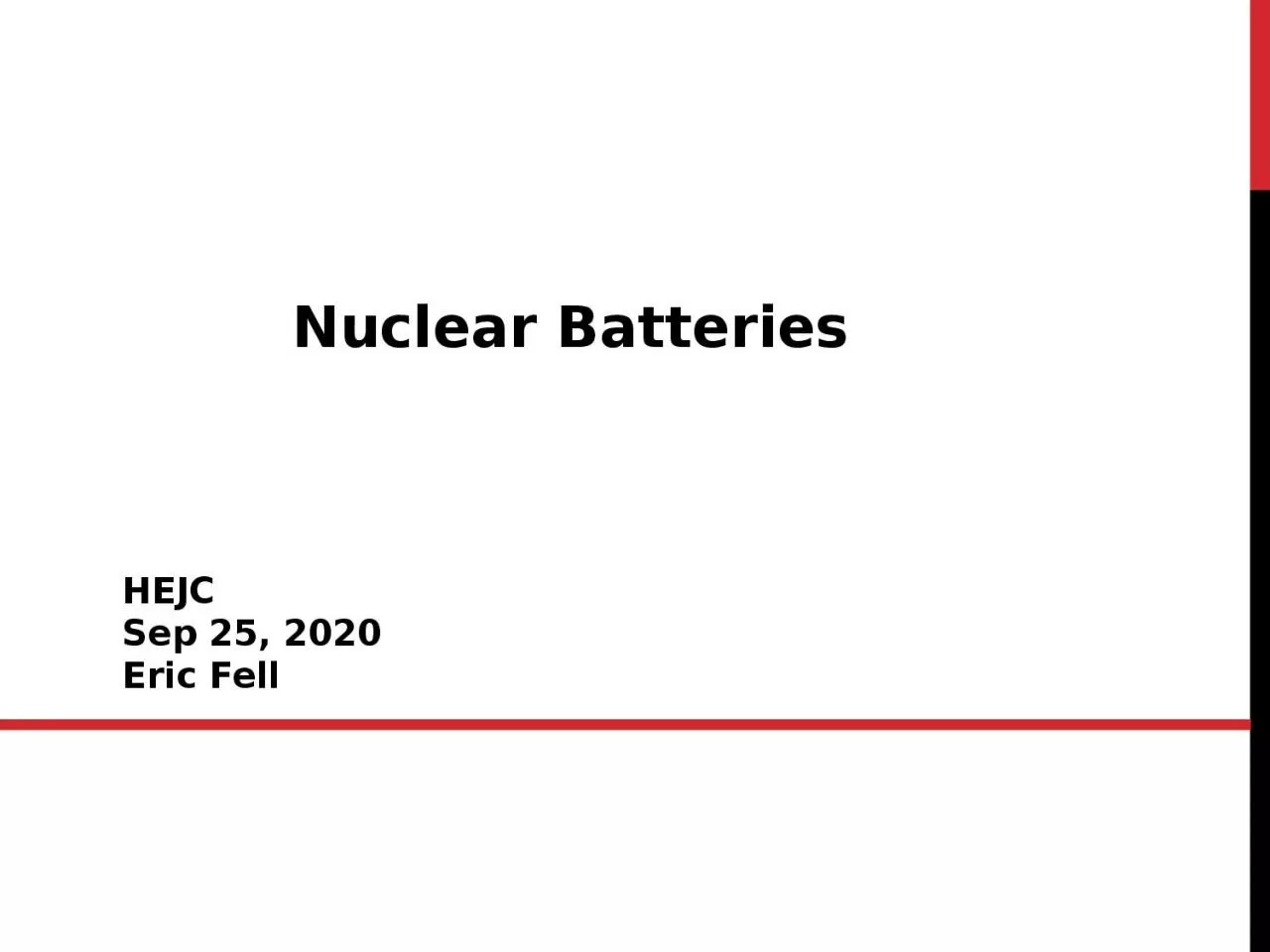

Eric Fell 2 Fundamentals of Nuclear Reactions httpfys246nuclearlusetopicsasp All elements have isotopes large range of stabilities Radioactive decay occurs in unstable isotopes resulting in spontaneous emission of particles andor electromagnetic radiation ID: 1040178
Download Presentation The PPT/PDF document "Nuclear Batteries HEJC Sep 25, 2020" is the property of its rightful owner. Permission is granted to download and print the materials on this web site for personal, non-commercial use only, and to display it on your personal computer provided you do not modify the materials and that you retain all copyright notices contained in the materials. By downloading content from our website, you accept the terms of this agreement.
1. Nuclear BatteriesHEJC Sep 25, 2020Eric Fell
2. 2Fundamentals of Nuclear Reactionshttp://fys246.nuclear.lu.se/topics.aspAll elements have isotopes, large range of stabilitiesRadioactive decay occurs in unstable isotopes, resulting in spontaneous emission of particles and/or electromagnetic radiationRepulsive force between protons must be balanced by a strong attractive force for nuclei stability
3. 3Types of Nuclear DecayOther decay processes includeGamma decayNeutron emissionElectron captureInternal conversionCluster decay / fission
4. 4Energy of nuclear decay comes from mass conversion, on the energy scale of MeV (1.6⨯10-13 J) released for every nuclear reactionMass-Energy Equivalence
5. 5Binding EnergyNuclear transmutations release energy equal to the difference between binding energy of nuclei in final and initial states
6. 6Battery/Energy Storage DeviceRechargeable?YesNoElectrochemical?YesNo
7. 7Nuclear BatteriesGenerate electricity from nuclear decay, without chain reactionsThermal ConversionThermoelectric Radioisotope thermoelectric generators (RTG)ThermionicRadioactive ‘hot’ electrode emits electrons over space-carrier barrier to a cooler electrodeNon-Thermal ConversionElectrostaticCharged particle buildup on a conductorRadiovoltaicAlpha/beta/gamma/neutron ionizing radiation through semiconductorsOptoelectricRadioluminescent material used, light converted to electricity
8. 8Radioisotope Thermoelectric Generators (RTGs)Convert heat from radioisotope decay into electricity, using thermocouples.IsotopePrimary decayShielding requiredPower density (W/g)Half-life (years)238PuαLow0.548890Srβ-High0.4629210PoαLow1400.4241AmαMedium0.11432https://en.wikipedia.org/wiki/Radioisotope_thermoelectric_generator238PuO2 pellet, initially 62 WSiGe semiconductor thermocouples typically used due to their low sensitivity to radiation damageOverall efficiency typically <10% 1 g of 238Pu generates 0.6 W
9. 9Radioisotope Thermoelectric Generators (RTGs) cont.Electric potential build up across a temperature gradient Seebeck effectRTGs use many thermocouples in series to get a usable voltage238PuO2Atmosphere/coolant
10. 10Radioisotope Thermoelectric Generators (RTGs) cont.Curiosity rover uses an RTG with 11 lbs of 238PuO2 Voyager 1,2 use 3 RTGs @157 W each
11. 11Pacemakers1967, Atomic Energy CommissionAlso an RTG design using 238PuO2Quickly replaced by lithium batteries once they became availableSome designs used 147Pm in Betavoltaic device
12. 12BetavoltaicsGenerate electric current from beta particle emission, using semiconductor junctions.Tritium is often used as it produces less radiation, half-life ~12.3 yearsBeta emission generates electron-hole pairs which separate due to built-in electric field. Accumulation of separated charge across np-junction leads to current flow through external circuitSimilar to photovoltaics, except much smaller currents
13. 13Betavoltaics cont.IsotopeAverage β Energy (keV)Maximum β Energy (keV)Half-life (years)3H5.71812.363Ni186792147Pm622252.6Because radiation damage of the semiconductor is a concern, β energy typically needs to be <300 keV Betavoltaics have niche low-power applications:Medical implants (pacemakers, pre ~1980s)Outer spaceIOT devices, electronicsTrickle-charging ‘High’ efficiency betavoltaic is typically 6-8%Commercialized ‘Betacel’ 1970s
14. 14Who’s currently working on Betavoltaics?Spinout from Cornell, founded 2008Still early stage commercialization, with VC funding from Lockheed and support from DODTech is silicon carbide betavoltaic, tritium or nickel, 2-6 V @ 1μW maxMiami-based, founded 2005All betavoltaic products use tritium 1-2.4 V @ 100μW max
15. 15Betavoltaic “Diamond Battery”Younger startup out of the Bay AreaAdvertise devices that are diamond-based, alpha/beta/neutron voltaic batteriesNo actual product reported yetInstead of using silicon as a semiconductor, replace it with doped diamond (5.5eV bandgap) which has a much higher resistance to radiation damage.https://www.sciencedirect.com/science/article/pii/S0925963517307495?via%3DihubUsing low-enriched 63Ni, 10μW/cm3 can be achieved
16. 16Betavoltaic “Diamond Battery” part 2Idea is to turn radioactive graphite (waste from decommissioned fission reactors, UK has a bunch), into diamond for battery active materialRemove 14C from graphite and synthesize artificial diamond structure Half-life is 5730 years so this would not be a high power density device
17. 17Future of Nuclear Batteries?RTG onboard Mars rover Perseverance, currently en route to MarsRTG tech is very much developed, next-gen continually being researched by academia, industry etc.Developed Betavoltaic tech does have a significant avenue in the low-power device market. Will likely continue to grow as interest in IOT, MEMS, trickle-charging develops Ignore the hype: we won’t see nuclear batteries in cars. Ever. And we don’t need millennia-lasting devices
18. 18Choppin, Liljenzin, Rydberg, Ekberg, Radiochemistry and Nuclear ChemistryChart of NuclidesCity labsWidetronixNDB inc.Further Reading